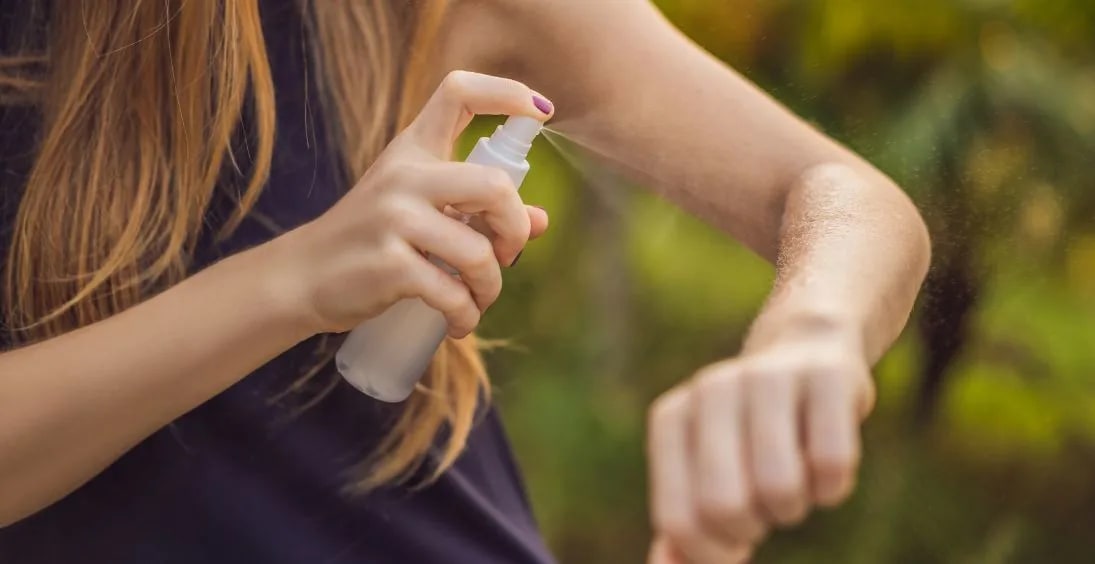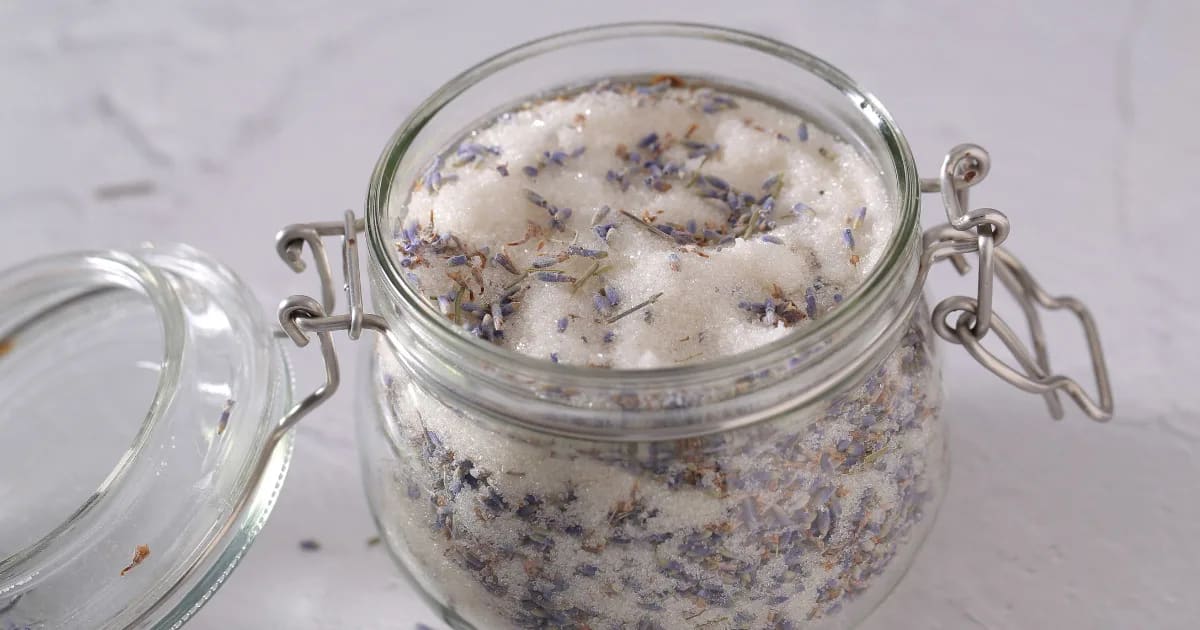Natural Bug Repellent Recipes & Protection with Essential Oils: DIY Mosquito & Insect Sprays

Summer, Bugs & Skin Protection
Every summer, there comes a moment when I get the first bite around my neck or scalp, perhaps from a mosquito or a little gnat. That’s when I know it’s time to make my summer bug spray blends. The goal is to keep bugs off my skin without coating myself in unhealthy, harsh chemicals.
As someone who cares about what goes on my body just as much as what goes in it, traditional bug repellent and DEET products have never been my go-to. But skipping protection isn’t an option either. Bug bites can be uncomfortable, and some insects can carry diseases.
So I’ve turned to natural ingredients. Making my own bug spray has become a summer ritual. In this post, you’ll learn how to protect your skin, soothe bites, and guard your peace of mind using plant-based strategies. Here’s what we’ll cover:
Why bites itch, sting, and swell, plus what’s really going on under your skin
The best natural insect repellent ingredients to keep mosquitoes, ticks, and biting flies away
How to soothe mosquito bites and other irritated skin naturally
The top essential oils, hydrosols, and carrier oils for summer skin care
Simple, effective DIY bug repellent spray recipes for you, your family, and your space
Why Bug Bites Itch & Sting
When you’re bitten or stung by pesky insects, your body kicks into protective mode. Your immune system recognizes the insect’s saliva or venom as a threat and releases histamine, a natural chemical that triggers inflammation and swelling in the area.
Here are the main reasons insect bites and stings cause such irritation:
Histamine reaction: This is your body’s built-in alarm system. It increases blood flow and sends white blood cells to the site of the bite, resulting in swelling, redness, and that infamous itch.
Venom or saliva proteins: Insects like mosquitoes, ticks, and wasps introduce substances into your skin that can cause mild to severe skin irritation or even pain.
Minor trauma to the skin: The bite itself breaks the skin, which can cause local inflammation even without an allergic response.
Allergic reactions: Some individuals are more sensitive than others to specific insect stings. A simple mosquito bite might barely register for one person and cause a golf-ball-sized welt on another.
You may also notice that you tend to get bitten more often or react more strongly than others around you. Factors like blood type, body chemistry, skin microbiome, and even how much carbon dioxide you exhale can make you more attractive to biting insects.
Synthetic vs Natural Bug Repellents
Many conventional insect and mosquito repellent products contain synthetic chemicals, such as DEET or permethrin, which, although effective, can be harsh on sensitive skin and raise concerns about long-term use, particularly for children and pregnant women.
When you’re shopping for a repellent product, look for the active ingredient listed on the label. Common synthetic active ingredients include:
DEET — A highly effective insect repellent, but it can be harsh on sensitive skin and is best used in moderation.
Picaridin — Found in products like Sawyer Picaridin Insect Repellent, picaridin offers similar protection to DEET with fewer odors and less skin irritation.
Permethrin — Used to treat clothing and gear, it repels and kills ticks and mosquitoes on contact, but should never be applied directly to skin.
Natural repellents, on the other hand, rely on botanicals as their active ingredients. While plant-based options smell better and can offer real protection, they usually provide shorter protection times and may be less effective in areas with a high risk of mosquito-borne infectious diseases. While they tend to be gentler, you must reapply them frequently.
When to Choose Natural Repellents vs Stronger Protection
While it’s tempting to ignore a few bites, regular insect bite and tick bite prevention is important. Bites can lead to infectious diseases, like Lyme and West Nile virus. Using a reliable repellent product, wearing long sleeves in high-risk areas, and practicing good post-bite skin care can help you stay safe all season and support disease control. (You may even wish to use an outdoor bug zapper.)
Of course, you can use natural insect repellents and DIY sprays whenever you like.
Alternatively, you can reserve them for everyday outdoor activities, such as gardening, backyard barbecues, or neighborhood walks. Conventional products (including Sawyer products, like Sawyer Picaridin Insect Repellent) or permethrin-treated clothing offer longer-lasting and stronger protection than natural alternatives. You may choose to rely on them when hiking in tick-endemic areas or traveling to regions where mosquito-borne diseases, such as West Nile virus or Lyme disease, are prevalent.
Always consider your skin type, personal health concerns, and the severity of the insect problem in your area.
Top Essential Oils for Natural Bug Repellents
There are several essential oils that help repel insects. It’s not easy to generalize because effectiveness depends on an oil’s chemistry, the type of insect, and even different species of the same insect (for example, the brown dog tick and the Lone Star tick may respond differently to cedarwood oil). Dilution also plays a role, and some research has been conducted with higher dilutions of essential oils than we’re comfortable using on our skin.
That said, essential oils have so much to offer! Let’s take a closer look at some of the best plant-based options and why they work.
Catnip (Nepeta cataria)
Mosquitoes
Ticks
Cockroaches
Flies
Catnip is a top natural mosquito repellent, and one of the most promising studied to date! The secret weapon is nepetalactone, the primary active compound in catnip essential oil. Multiple studies have shown that nepetalactone can repel mosquitoes as well as, or better than, DEET.
A 2019 study found that catnip oil and isolated nepetalactones offered over 95% protection for 2 to 4 hours after application (Reichert et al. 2019). Even at low concentrations, catnip outperformed DEET in preventing mosquito landings. More recent research (Batume et al., 2024) confirmed that catnip oil diluted to just 2% still repelled over 70% of mosquitoes for up to four hours. The key is to ensure you’re using an oil high in nepetalactone, which is typically about 80% or more.
Catnip oil also showed promise as a tick repellent.

Clove Bud (Syzygium aromaticum)
Mosquitoes
Ticks
Ants
Flies
Clove bud oil is another potent natural insect repellent! Its primary active compound, eugenol, is responsible for its strong bug-repelling properties against ticks and mosquitoes. In multiple lab studies, clove bud oil is shown to be effective in low concentrations, making it more potent than many other essential oils (Deng et al., 2023).
Clove bud oil may also offer longer protection time than other natural options. One study found that when clove bud oil was formulated in an organic lotion base at 5–10%, it provided significantly longer complete protection times against mosquitoes (Lopez et al., 2025). When combined with eucalyptus oil in a 1:1 ratio, the blend achieved an impressive 94% repellency. While this is exciting, we don’t recommend applying clove bud to the skin in a 5% dilution. It’s an incredibly potent oil that can cause irritation to the skin and mucous membranes.
We suggest avoiding clove bud oil on very sensitive areas or broken skin. We also prefer to avoid it for children younger than 10. Clove bud should be used with caution on those with impaired liver function and should not be used by people who have clotting disorders.

Citronella Java (Cymbopogon winterianus)
Mosquitoes
Ticks
Fleas
Flies
Citronella is probably the most well-known natural mosquito repellent. The Java variety has high levels of citronellal and geraniol, compounds that discourage mosquitoes from landing.
In a 2015 study (Yoon et al. 2015), a 5% citronella oil product was tested on 20 volunteers. It created near-total protection, initially repelling 98% of mosquitoes. However, that level of repellency didn’t last. Its complete protection time was just about 10.5 minutes on average. After that, the effectiveness started to drop. (For comparison, in the same study, a 24% DEET product offered more than 90% protection for a full six hours.)

Patchouli (Pogostemon cablin)
Mosquitoes
Ticks
Ants
Flies
Best known for its deep, earthy scent, patchouli essential oil is also an effective insect repellent. Unlike many other essential oils, patchouli’s aroma tends to linger. That makes it useful in outdoor diffusers or clothing sprays where you want staying power.
In one mosquito study (Gokulakrishnan et al. 2013), patchouli provided 100% protection for over four and a half hours. More recent research (Le Mauff et al., 2024) confirms its effectiveness against a range of pests, including the Lone Star tick.
However, once diluted, patchouli’s repellency does drop. It’s not as effective as synthetic options, especially for ticks, but it’s still a valuable tool in your natural bug-repelling toolkit. When used in synergy with other oils, it can help extend the longevity of your blends.
Patchouli is the main essential oil in one of our favorite bug-away blends. Find the recipe here!

Cedarwood (Juniperus virginiana)
Ticks
Mosquitoes
Fleas
Ants
Moths
Cedarwood has long been valued for repelling insects. The star component is cedrol, which can interfere with insect sensory receptors, confusing their ability to locate a host. Studies have found it useful for repelling ticks, ants, cockroaches, and even moths. Cedarwood oil is known as a natural, safe tick repellent, sometimes performing on par with DEET for some tick species (Flor-Weiler et al. 2022).
That said, cedarwood hasn’t held up well in tests with mosquitoes (Barnard, 1999). However, when used as a barrier treatment (on clothes, furniture, or along baseboards) cedarwood can protect against a range of pests (National Toxicology Program, 2016). (Get more tips to bug-proof your home with aromatherapy!)

Eucalyptus (Eucalyptus globulus & citriodora)
Mosquitoes
Flies
Ticks (especially Eucalyptus citriodora)
Eucalyptus oil is rich in 1,8-cineole (eucalyptol). In a 2021 study (Sheikh et al., 2021), a 10% dilution of eucalyptus oil provided 77.78% protection against mosquito landings, making it a decent insect repellent on its own, and it was even more effective when combined with clove bud (Syzygium aromaticum).
Lemon-scented eucalyptus (Eucalyptus citriodora) was even stronger at repelling mosquitoes, lasting up to 8 hours in one lab study (Asadollahi et al. 2019).
The research is encouraging, but we don’t recommend applying eucalyptus at a full 10% dilution. We also suggest avoiding eucalyptus oil on very sensitive areas or broken skin. We also prefer to avoid it for children younger than 10.

Geranium (Pelargonium graveolens)
Mosquitoes
Ticks
Flies
Geranium essential oil offers a lovely combination of beauty and bite protection. Known for its floral, rosy aroma, this oil also packs a punch against ticks and mosquitoes.
A 2013 study in the Journal of Agricultural and Food Chemistry found that geranium oil significantly reduced tick attachment rates (Tabanca et al. 2013). Not all geranium oils are equally effective, as repellency depends on the specific plant strain and chemical composition. But the right chemotype shows real promise as a natural alternative to DEET, especially when used at an adequate concentration.

Tea Tree Oil (Melaleuca alternifolia)
Mosquitoes
Flies
Ticks
Ants
Lice
Tea tree oil typically contains between 30% and 40% terpinen-4-ol (Carson et al., 2006). Research pinpoints terpinen-4-ol as having moderate but meaningful mosquito-repellent activity (Li et al., 2020). Not only does terpinen-4-ol repel mosquitoes, but it also shows significant toxicity against adult mosquitoes, making it a promising natural insecticide.
One challenge with essential oils, such as tea tree oil, is that their active compounds can evaporate quickly when applied to the skin or surfaces. This means they must be reapplied frequently.

Other essential oils that may help repel insects:
Lemongrass Oil (Cymbopogon citratus)
Oregano Oil (Origanum vulgare)
Palmarosa Oil (Cymbopogon martinii var motia)
Peppermint Oil (Mentha × piperita)
Rosemary ct 1,8-cineole Oil (Salvia rosmarinus ct 1,8-cineole)
Thyme ct thymol Oil (Thymus vulgaris ct thymol) (Learn how this chemotype of thyme differs from others.)
Essential Oils to Soothe Bites & Irritated Skin
Even the best bug repellent can’t guarantee a completely bite-free summer. When pesky mosquito bites, tick bites, or other insect stings do happen, natural remedies can calm inflammation, reduce itching, calm histamine reactions, ease pain, and help prevent infection.
Here are some of our favorite essential oils for soothing irritation after a bite:
Lavender (Lavandula angustifolia)
Known for its powerful anti-inflammatory and calming properties, lavender oil is a go-to for reducing redness and swelling caused by insect bites (Peana et al. 2002). Learn why lavender is so effective!Tea Tree (Melaleuca alternifolia)
Along with helping to prevent bites, tea tree oil can be useful after you do get bit. It’s excellent at calming histamine reactions in the skin (Koh et al. 2002). We even love using it to reduce allergies.German Chamomile (Matricaria recutita)
This essential oil contains compounds with strong antihistamine-like effects, helping to calm redness and irritation quickly (Mitoshi et al. 2012). Its soothing nature makes it ideal for sensitive or reactive skin, especially in children. (Be aware that German and Roman chamomile are not directly interchangeable.)Peppermint (Mentha × piperita)
Peppermint offers a natural cooling and mild numbing sensation that can relieve the immediate discomfort of a mosquito bite or other bites. Its menthol content helps distract the nervous system from itch signals (Pergolizzi et al. 2018), and makes it excellent for pain relief.
Hydrosol Helpers: Gentle Relief and Added Protection
Hydrosols are aromatic waters produced with steam distillation. They’re milder than essential oils and can be applied liberally, even on sensitive or children’s skin. (Learn more about hydrosols and how to use them!)
Catnip Hydrosol (Nepeta cataria)
Along with its natural insect-repellent qualities, catnip hydrosol is also gentle enough to soothe irritation from bites without stinging or dryness.Eucalyptus Hydrosol (Eucalyptus globulus)
This cooling hydrosol also supports respiratory health, making it a versatile summer staple for outdoor living. Spritz it on skin to refresh your repellent or for itch relief.Cinnamon Hydrosol (Cinnamomum verum)
Cinnamon hydrosol has natural antimicrobial and insect repellent properties, making it a powerful ally during buggy summer months. It can be too intense for sensitive skin but works beautifully as a space spray, fabric spray, or diluted in blends.Lemon Thyme Hydrosol (Thymus citriodorus)
Zesty and herbaceous, lemon thyme hydrosol offers gentle, skin-safe protection against mosquitoes and gnats. It also helps calm itchy bites, especially when chilled.Peppermint Hydrosol (Mentha × piperita)
Cooling and invigorating, peppermint hydrosol provides instant relief from the heat, as well as from inflamed or itchy bites.
The Best Carriers for Your DIY Bug Repellent Spray or Soothing Oils
Carrier oils are key for safely diluting essential oils, ensuring they absorb well and nourish the skin.
Arnica-Infused Olive Oil (Arnica montana in Olea europaea)
This soothing oil blend helps reduce swelling and bruising caused by bites or stings, promoting skin repair.Hemp Seed Oil (Cannabis sativa)
Lightweight and fast-absorbing, hemp seed oil hydrates without clogging pores, perfect for hot summer days and exposed skin.Sweet Almond Oil (Prunus amygdalus var dulcis)
A classic carrier oil, sweet almond oil is gentle, moisturizing, and suitable for all skin types, providing a smooth base for your blends.Trauma Oil
Trauma oil is a combination of three herbally infused oils: calendula, St. John’s wort, and arnica. Each of these infusions are profoundly restorative for damaged skin and soothing for discomfort. Together, they make a powerhouse carrier that earns its name for trauma care!
DIY Essential Oil Recipes for Outdoor Protection
Catnip Bug-Off Body Oil
This nourishing body oil serves double duty, working as both an insect repellent and leaving your skin feeling soft and smooth. Hemp seed oil provides a lightweight, fast-absorbing base. You can use this blend daily on arms, legs, neck, and shoulders. Reapply every 2–3 hours for continuous benefits.
Ingredients
1 fl oz (30 ml) Hemp Seed Oil (Cannabis sativa)
10 drops Catnip Oil (Nepeta cataria)
3 drops Geranium Oil (Pelargonium graveolens var roseum)
3 drops Eucalyptus Oil (Eucalyptus citriodora)
1 drop Clove Bud Oil (Syzygium aromaticum)
Directions
Combine the ingredients in a 1fl oz (30 ml) glass or PET bottle. Apply before spending time outdoors in buggy areas.
If you’re making this blend for children younger than 10, adjust the essential oils:
10 drops Catnip Oil (Nepeta cataria)
3 drops Geranium Oil (Pelargonium graveolens var roseum)
Do you have sensitive skin? We crafted 3 different bug-repelling blends for different skin needs. Find them in this post on The Aromahead Blog.
Refreshing Insect Repellent Spray
This light, hydrosol-based spray is perfect for refreshing your protection between applications of your Catnip Bug-Off Body Oil. Mist it on exposed skin, clothing, and even outdoor seating to add an extra layer of plant-powered defense.
Ingredients
Nearly 1.5 fl oz (45 ml) Catnip Hydrosol (Nepeta cataria)
½ fl oz (15 ml) Eucalyptus Hydrosol (Eucalyptus globulus)
8 ml Solubol dispersant
20 drops Catnip Oil (Nepeta cataria)
15 drops Cedarwood Oil (Juniperus virginiana)
10 drops Citronella Java Oil (Cymbopogon winterianus)
Directions
Combine the essential oils and Solubol in a 2 fl oz (60 ml) spray bottle. The Solubol will help keep the essential oils dispersed through the water-based ingredients (hydrosols).
Fill the bottle the rest of the way with the hydrosols and shake well.
Avoid spraying near the eyes and face. Reapply frequently, especially after sweating or swimming.
Shake well before each use. This blend is made without preservatives. Store in a cool, dark area and make fresh every few weeks.
If you’re making this blend for children younger than 10, adjust the essential oils:
5 drops Catnip Oil (Nepeta cataria)
4 drops Cedarwood Oil (Juniperus virginiana)
3 drops Citronella Java Oil (Cymbopogon winterianus)
Cedarwood Tick-Repellent Body Oil
This potent yet skin-friendly blend is crafted to help keep ticks at bay. It’s ideal for daily protection during hikes, gardening, or time in wooded areas. Hemp seed oil makes an excellent base, lightweight, nourishing, and easily absorbed without greasiness.
Apply generously to skin, especially around the ankles, waist, and behind the knees, places where ticks love to crawl and hide.
Ingredients
1 fl oz (30 ml) Hemp Seed Oil (Cannabis sativa)
10 drops Cedarwood Oil (Juniperus virginiana)
4 drops Thyme ct thymol Oil (Thymus vulgaris ct thymol)
3 drops Geranium Oil (Pelargonium graveolens var roseum)
2 drops Clove Bud Oil (Syzygium aromaticum)
Directions
Combine the ingredients in a 1 fl oz (30 ml) glass or PET bottle. Apply before spending time outdoors in areas where ticks are prevalent.
Avoid applying near the eyes or broken skin. Reapply every few hours, or after sweating or swimming. Use in conjunction with permethrin-treated clothing for enhanced protection in high-risk zones.
If you’re making this blend for children younger than 10, adjust the essential oils:
6 drops Cedarwood Oil (Juniperus virginiana)
2 drops Geranium Oil (Pelargonium graveolens var roseum)
Insect Repellent Laundry Spray
Keep clothes and linens bug-free naturally! This herbal bug spray lightly scents fabrics with bug-repelling essential oils, helping deter mosquitoes, ticks, moths, and other pests without synthetic chemicals. Lightly mist on clothing, bedding, and outdoor fabrics before use or storage. Especially helpful for camping gear, hiking clothes, or picnic blankets. Let fabrics dry before wearing.
Ingredients
2 fl oz (60 ml) Lemon Thyme Hydrosol (Thymus citriodora)
6 ml Solubol dispersant
25 drops Cedarwood Oil (Juniperus virginiana)
10 drops Citronella Java Oil (Cymbopogon winterianus)
Directions
Combine the essential oils and Solubol in a 2 fl oz (60 ml) spray bottle. The Solubol will help keep the essential oils dispersed through the water-based ingredients (hydrosol).
Fill the bottle the rest of the way with the hydrosol and shake well.
Shake well before each use. This blend is made without preservatives. Store in a cool, dark area and make fresh every few weeks.
Yard & Spatial Repellent Diffuser Blend
Transform your outdoor space into a no-fly zone! This earthy, floral blend combines three insect-repelling powerhouses to help keep mosquitoes and other pests at bay during backyard gatherings. Perfect for patios, porches, garden dinners, and yard parties. Add the oils to your outdoor diffuser or lantern-style ring diffuser. For best results, pair with physical barriers such as screens and netting, and start diffusing 10–15 minutes before your guests arrive.
Adjust the quantities based on the size of your diffuser and the space available. Refresh as needed to maintain coverage throughout the evening.
Ingredients
5 drops Cedarwood Oil (Juniperus virginiana)
5 drops Geranium Oil (Pelargonium graveolens var roseum)
5 drops Patchouli Oil (Pogostemon cablin)
Directions
Add essential oils to your outdoor diffuser or lantern ring diffuser.
Diffuse during outdoor gatherings to create a natural spatial repellent barrier against biting insects.
Bug-Repellent Room & Tent Spray
Create a cozy, bug-free zone inside tents, cabins, and rooms with this spicy, earthy, and citrus-bright spray. It helps discourage mosquitoes and flying pests, yet it's gentle enough for use on fabrics and in enclosed spaces.
Ingredients
2 fl oz (60 ml) Cinnamon Hydrosol (Cinnamomum verum)
7 ml Solubol dispersant
17 drops Citronella Java Oil (Cymbopogon winterianus)
17 drops Lemongrass Oil (Cymbopogon citratus)
15 drops Patchouli Oil (Pogostemon cablin)
10 drops Clove Bud Oil (Syzygium aromaticum)
Directions
Combine the essential oils and Solubol in a 2 fl oz (60 ml) spray bottle. The Solubol will help keep the essential oils dispersed through the water-based ingredients (hydrosol).
Fill the bottle the rest of the way with the hydrosol and shake well.
This recipe isn’t intended for skin application, but we’ve included Solubol dispersant to ensure the oils remain dispersed throughout the hydrosol. Shake well before each use. This blend is made without preservatives. Store in a cool, dark area and make fresh every few weeks.
DIY Essential Oil Itch Stick
This popular recipe from our blog is a go-to summer classic at Aromahead!
Sting Relief Cooling Gel
This refreshing gel offers fast, cooling relief for itchy, inflamed bites and stings. Aloe vera calms and hydrates the skin, while eucalyptus hydrosol adds a gentle cleansing effect. Peppermint oil delivers a cooling tingle to ease discomfort, and German chamomile helps reduce redness, inflammation, and histamine reactions.
Ingredients
½ oz (14 g) Aloe Vera Gel (Aloe barbadensis)
½ fl oz (15 ml) Eucalyptus Hydrosol (Eucalyptus globulus)
3 ml Solubol dispersant
12 drops Peppermint Oil (Mentha × piperita)
6 drops German Chamomile Oil (Matricaria recutita)
Directions
Combine the essential oils and Solubol in a 1 oz (30 ml) glass or PET bottle. The Solubol will help keep the essential oils dispersed through the water-based ingredients (hydrosol and aloe vera gel).
Add the aloe vera.
Fill the bottle the rest of the way with the hydrosol and shake well.
Keep refrigerated for an extra soothing effect. Shake well before each use. This blend is made without preservatives. Store in a cool, dark area and make fresh every few weeks.
My Takeaway: Enjoy Summer Without the Sting
Summer invites us to slow down, breathe deep, and soak in the sun’s golden warmth. It doesn’t have to come with the sting of itchy bites or the concern of harsh chemicals on our skin. With the right repellent products, thoughtfully chosen essential oils, and gentle aftercare, you can step outside with quiet confidence and joy.
Nature offers us a soft shield, one that hums with the scent of citronella and cedarwood, cools with lavender’s embrace, and soothes with German chamomile’s tender touch. By trusting in these gifts, we honor our wellness while keeping bugs at bay. With nature on our side, we can truly enjoy summer without the sting.
Get Natural Solutions for Sunburn, Too!
Bugs aren’t the only things that can ruin a perfectly beautiful sunny day. Sunburn and excessive heat can also pose risks.
Download your free Summer Essentials Bundle and get instant access to kid-safe remedies, after-sun skin care, and easy, effective plant-based recipes for the whole family. Grab your free bundle and make this your most supported, sun-soaked summer yet!
REFERENCES
Asadollahi, A., Khoobdel, M., Zahraei-Ramazani, A., Azarmi, S., & Mosawi, S. H. (2019). Effectiveness of plant-based repellents against different Anopheles species: a systematic review. Malaria journal, 18(1), 436. https://doi.org/10.1186/s12936-019-3064-8
Baker, B. P., Grant, J. A., & Malakar-Kuenen, R. (2018). Peppermint & peppermint oil profile: Active ingredient eligible for minimum risk pesticide use. New York State Integrated Pest Management Program, Cornell University.
Barnard D. R. (1999). Repellency of essential oils to mosquitoes (Diptera: Culicidae). Journal of medical entomology, 36(5), 625–629. https://doi.org/10.1093/jmedent/36.5.625
Batume, C., Mulongo, I. M., Ludlow, R., Ssebaale, J., Randerson, P., Pickett, J. A., Mukisa, I. M., & Scofield, S. (2024). Evaluating repellence properties of catnip essential oil against the mosquito species Aedes aegypti using a Y-tube olfactometer. Scientific Reports, 14, Article 2269. https://doi.org/10.1038/s41598-024-40011-6
Carson, C. F., Hammer, K. A., & Riley, T. V. (2006). Melaleuca alternifolia (tea tree) oil: a review of antimicrobial and other medicinal properties. Clinical microbiology reviews, 19(1), 50-62.
Deng, W., Li, M., Liu, S., Logan, J. G., & Mo, J. (2023). Repellent Screening of Selected Plant Essential Oils Against Dengue Fever Mosquitoes Using Behavior Bioassays. Neotropical entomology, 52(3), 521–529. https://doi.org/10.1007/s13744-023-01039-z
Flor-Weiler, L. B., Behle, R. W., Eller, F. J., Muturi, E. J., & Rooney, A. P. (2022). Repellency and toxicity of a CO2-derived cedarwood oil on hard tick species (Ixodidae). Experimental & applied acarology, 86(2), 299–312. https://doi.org/10.1007/s10493-022-00692-0
Gokulakrishnan, J., Kuppusamy, E., Shanmugam, D., Appavu, A., & Kaliyamoorthi, K. (2013). Pupicidal and repellent activities of Pogostemon cablin essential oil chemical compounds against medically important human vector mosquitoes. Asian Pacific Journal of Tropical Disease, 3(1), 26–31. https://doi.org/10.1016/S2222-1808(13)60006-7
Kang, S.-H., Kim, M.-K., Seo, D.-K., Noh, D.-J., Yang, J.-O., Yoon, C., & Kim, G.-H. (2009). Comparative repellency of essential oils against Culex pipiens pallens (Diptera: Culicidae). Journal of the Korean Society for Applied Biological Chemistry, 52(4), 353–359.
Klauck, V., Pazinato, R., Stefani, L. M., Santos, R. C., Vaucher, R. A., Baldissera, M. D., Raffin, R., Boligon, A., Athayde, M., Baretta, D., Machado, G., & DA Silva, A. S. (2014). Insecticidal and repellent effects of tea tree and andiroba oils on flies associated with livestock. Medical and veterinary entomology, 28 Suppl 1, 33–39. https://doi.org/10.1111/mve.12078
Klocke, J.A., Darlington, M.V. & Balandrin, M.F. 1,8-Cineole (Eucalyptol), a mosquito feeding and ovipositional repellent from volatile oil ofHemizonia fitchii (Asteraceae). J Chem Ecol 13, 2131–2141 (1987). https://doi.org/10.1007/BF01012562
Koh, K. J., Pearce, A. L., Marshman, G., Finlay‐Jones, J. J., & Hart, P. H. (2002). Tea tree oil reduces histamine‐induced skin inflammation. British Journal of Dermatology, 147(6), 1212-1217.
Kumar, S., Wahab, N., & Warikoo, R. (2011). Bioefficacy of Mentha piperita essential oil against dengue fever mosquito Aedes aegypti L. Asian Pacific journal of tropical biomedicine, 1(2), 85–88. https://doi.org/10.1016/S2221-1691(11)60001-4
Le Mauff, A., Norris, E. J., Li, A. Y., & Swale, D. R. (2024). Repellent activity of essential oils to the Lone Star tick, Amblyomma americanum. Parasites & vectors, 17(1), 202. https://doi.org/10.1186/s13071-024-06246-0
Li, M.-X., Ma, Y.-P., Zhang, H.-X., Sun, H.-Z., Su, H.-H., Pei, S.-J., & Du, Z.-Z. (2021). Repellent, larvicidal and adulticidal activities of essential oil from Dai medicinal plant Zingiber cassumunar against Aedes albopictus. Plant Diversity, 43(4), 317–323. https://doi.org/10.1016/j.pld.2020.11.008
Lopez, A. D., Whyms, S., Luker, H. A., Galvan, C. J., Holguin, F. O., & Hansen, I. A. (2025). Repellency of Essential Oils and Plant-Derived Compounds Against Aedes aegypti Mosquitoes. Insects, 16(1), 51. https://doi.org/10.3390/insects16010051
Mitoshi, M., Kuriyama, I., Nakayama, H., Miyazato, H., Sugimoto, K., Kobayashi, Y., Jippo, T., Kanazawa, K., Yoshida, H., & Mizushina, Y. (2012). Effects of essential oils from herbal plants and citrus fruits on DNA polymerase inhibitory, cancer cell growth inhibitory, antiallergic, and antioxidant activities. Journal of Agricultural and Food Chemistry, 60(45), 11343–11350. https://doi.org/10.1021/jf303377f
National Toxicology Program. (2016, November). NTP technical report on the toxicity studies of cedarwood oil (Virginia) (CASRN 8000-27-9) administered dermally to F344/N rats and B6C3F1/N mice: Toxicity report 86. National Toxicology Program. https://www.ncbi.nlm.nih.gov/books/NBK552536/
Peana, A.T., D’Aquila, P.S., Panin, F., Serra, G., Pippia, P. and Moretti, M.D. (2002) Anti-inflammatory activity of linalool and linalyl acetate constituents of essential oils. Phytomedicine 9, 721-726
Pergolizzi Jr, J. V., Taylor Jr, R., LeQuang, J. A., Raffa, R. B., & NEMA Research Group. (2018). The role and mechanism of action of menthol in topical analgesic products. Journal of clinical pharmacy and therapeutics, 43(3), 313-319.
Reichert, W., Ejercito, J., Guda, T., Dong, X., Wu, Q., Ray, A., & Simon, J. E. (2019). Repellency Assessment of Nepeta cataria Essential Oils and Isolated Nepetalactones on Aedes aegypti. Scientific reports, 9(1), 1524. https://doi.org/10.1038/s41598-018-36814-1
Sheikh, Z., Amani, A., Basseri, H. R., Kazemi, S. H. M., Sedaghat, M. M., Azam, K., Azizi, M., & Amirmohammadi, F. (2021). Repellent Efficacy of Eucalyptus globulus and Syzygium aromaticum Essential Oils against Malaria Vector, Anopheles stephensi (Diptera: Culicidae). Iranian journal of public health, 50(8), 1668–1677. https://doi.org/10.18502/ijph.v50i8.6813
Tabanca, N., Wang, M., Avonto, C., Chittiboyina, A. G., Parcher, J. F., Carroll, J. F., Kramer, M., & Khan, I. A. (2013). Bioactivity-guided investigation of geranium essential oils as natural tick repellents. Journal of agricultural and food chemistry, 61(17), 4101–4107. https://doi.org/10.1021/jf400246a
Trongtokit, Y., Rongsriyam, Y., Komalamisra, N., & Apiwathnasorn, C. (2005). Comparative repellency of 38 essential oils against mosquito bites. Phytotherapy research : PTR, 19(4), 303–309. https://doi.org/10.1002/ptr.1637
Yoon, J. K., Kim, K. C., Cho, Y., Gwon, Y. D., Cho, H. S., Heo, Y., Park, K., Lee, Y. W., Kim, M., Oh, Y. K., & Kim, Y. B. (2015). Comparison of Repellency Effect of Mosquito Repellents for DEET, Citronella, and Fennel Oil. Journal of parasitology research, 2015, 361021. https://doi.org/10.1155/2015/361021






